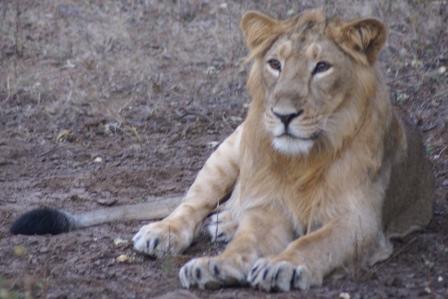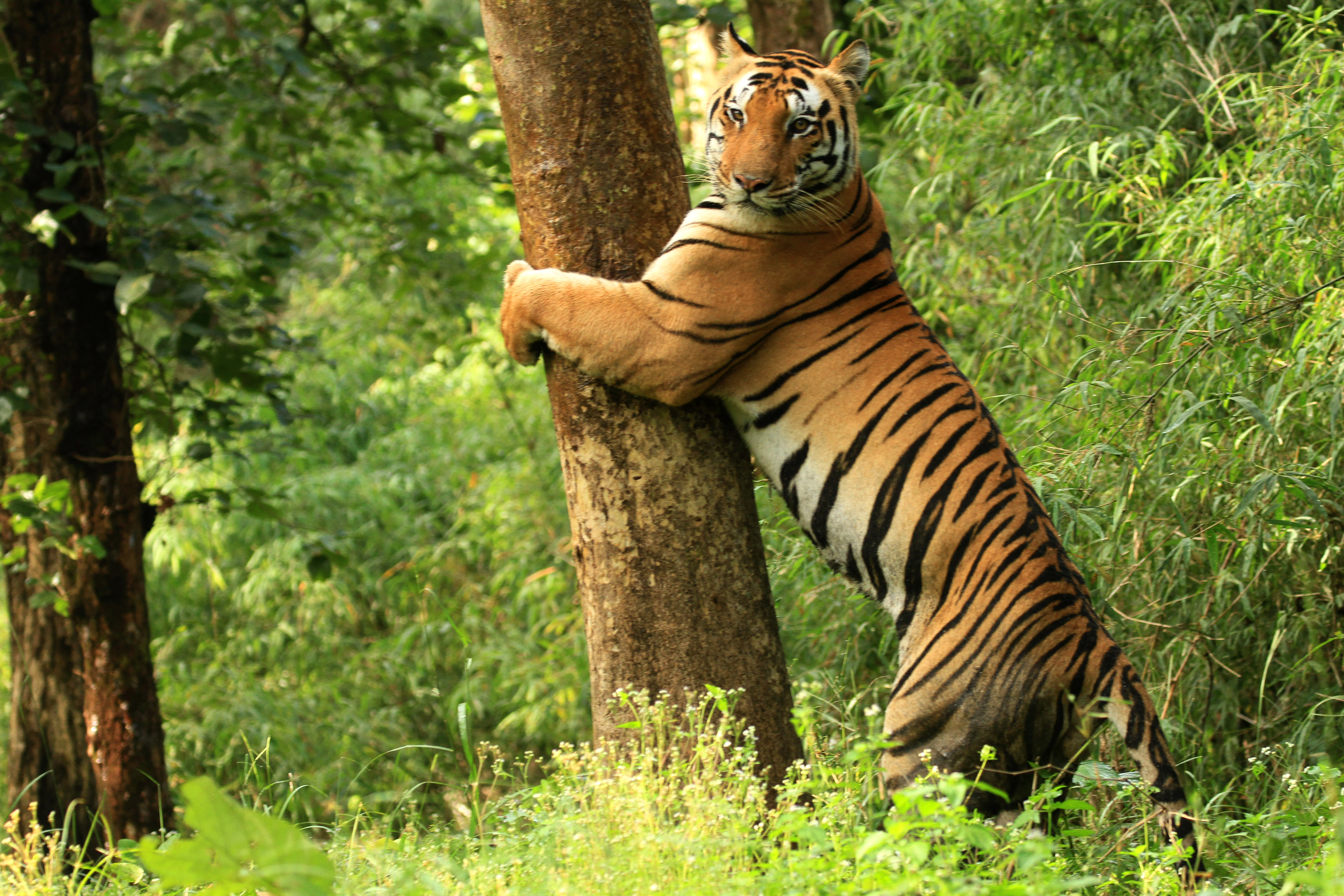INTRODUCTION
 |
| Asiatic Lion, Gir Reserve Forest, India M1shra at English Wikipedia, Public domain, via Wikimedia Commons |
Among these marvels, India’s wildlife stands out as one of its greatest treasures.
Stretching from the Himalayan highlands to the dense jungles of central India, and from the deserts of Rajasthan to the mangroves of the Sundarbans, the nation’s forests and sanctuaries preserve a dazzling variety of flora and fauna.
With rainforests, grasslands, wetlands, and deciduous forests, India offers every kind of ecosystem that wild animals and birds require. From food and water to shelter and breeding grounds, these habitats are rich in natural provisions. Over the years, many areas have been declared Reserve Forests, National Parks, and Wildlife Sanctuaries, ensuring that both animals and birds can live free from harm. For travelers, these natural paradises provide not only breathtaking beauty but also world-class tourist facilities, making a visit both adventurous and comfortable.
If any tourists need any help, here is the official website of the Government of India to guide the domestic and foreign tourists: India Tourism Development Corporation (ITDC)
In this essay, we will journey through India’s most iconic wildlife sanctuaries and reserves—places where lions roam, tigers rule, elephants march in herds, and birds sing fearlessly.
India’s Wildlife Heritage
 |
| Indian peafowl in Jim Corbett National Park, India Giles Laurent, CC BY-SA 4.0, via Wikimedia Commons |
The Gir National Park in Gujarat is the last refuge of the Asiatic Lion, a species once on the brink of extinction. In central India, the mighty Royal Bengal Tiger prowls in sanctuaries like Kanha, Bandhavgarh, and Pench, while the wetlands of Bharatpur and Kaziranga teem with migratory birds and rhinos.
In earlier times, these forests echoed with the hunting horns of kings and emperors. Mughal and Rajput rulers hunted tigers and lions as symbols of power. During the British colonial era, officers also turned these forests into their playgrounds, further depleting populations of big cats and other species. By the mid-20th century, animals like the Asiatic lion and Bengal tiger were pushed dangerously close to extinction.
Thankfully, independent India took strong measures. Hunting was banned, and conservation programs such as Project Tiger (1973) and the Wildlife Protection Act (1972) were introduced. Today, the story has changed. India is now a global leader in wildlife conservation, home to over 100 national parks, 500 wildlife sanctuaries, and numerous biosphere reserves.
Gir National Park: The Last Home of the Asiatic Lion
 |
| Asiatic Lion, Gir Reserve Forest, India Sutariyaabhishek, CC BY-SA 4.0, via Wikimedia Commons |
Once found across Asia, these lions now survive only here, thanks to tireless conservation efforts.
A safari through Gir offers the chance to see not only lions but also leopards, striped hyenas, jackals, antelopes, and over 300 species of birds. The dry deciduous forest, with its teak and acacia trees, forms a unique backdrop for photography.
Tourists visiting Gir are reminded never to tease or disturb the animals. Unlike the past—when lions were hunted mercilessly—today they are revered symbols of India’s natural pride. Comfortable lodges and safari facilities around Gir make it easy for travelers to enjoy the wilderness while staying close to nature.
Jim Corbett National Park: The First Tiger Reserve
 |
| Jim Corbet Park, India—A spotted deer Subhrajyoti07, CC BY-SA 4.0, via Wikimedia Commons |
Visitors to Corbett can embark on jeep or elephant safaris to spot tigers, leopards, elephants, and spotted deer. The Ramganga River that flows through the park attracts marsh crocodiles, gharials, and migratory birds. With over 500 species of birds, Corbett is a paradise for ornithologists. Darters, grey herons, storks, and kingfishers add color to the park’s wetlands.
Easily accessible from New Delhi and Lucknow, with Ramnagar as the nearest railway station, Corbett offers an ideal blend of wilderness and comfort. Resorts, eco-lodges, and government rest houses ensure that travelers can stay amid nature without compromising on modern amenities.
Kanha National Park: The Inspiration for “The Jungle Book”
 |
| Tiger in Kanha Tiger Reserve Davidvraju, CC BY-SA 4.0, via Wikimedia Commons |
Its grassy meadows, bamboo groves, and sal forests provide a perfect habitat for tigers, leopards, wild dogs, and sloth bears.
Kanha is also famous for the barasingha (swamp deer), which was once close to extinction but has now made a remarkable comeback due to conservation efforts. Safaris through Kanha’s lush landscapes offer sightings of chital (spotted deer), sambar, gaur (Indian bison), and countless bird species.
Easily reachable from Jabalpur, Kanha offers excellent accommodations, from budget guesthouses to luxury jungle resorts. Travelers often describe their safari here as stepping into a dreamland where wildlife thrives in harmony with nature.
Kaziranga National Park: The Land of the One-Horned Rhino
 |
| Diganta Talukdar, CC BY-SA 4.0, via Wikimedia Commons Rhinos in Kaziranga National Park |
On the banks of the mighty Brahmaputra River in Assam lies Kaziranga National Park, a UNESCO World Heritage Site famous for its population of the one-horned rhinoceros.
Spread over 430 square kilometers, Kaziranga also shelters elephants, swamp deer (barasingha), wild buffaloes, and the elusive tiger.
Tall elephant grass, lush wetlands, and dense forests create a perfect habitat for wildlife. The park is also an Important Bird Area, home to hundreds of resident and migratory birds.
 |
| A roller (Coracias affinis)—Kaziranga National Park Peter Andersen, CC BY-SA 3.0, via Wikimedia Commons |
Vultures, storks, eagles, and pelicans thrive here. Jeep and elephant safaris allow visitors to explore the terrain, but hiking is prohibited to ensure minimal disturbance to animals.
Kaziranga can be reached from Guwahati (200 km) or Jorhat (100 km) by air and Furkating railway station (75 km) by train. For travelers, the combination of Assamese cuisine, warm hospitality, and thrilling safaris makes Kaziranga an unforgettable experience.
Other Notable Parks and Sanctuaries
Beyond these iconic reserves, India is blessed with countless other sanctuaries:
-
Ranthambore National Park (Rajasthan): Famous for tiger sightings and historic Ranthambore Fort.
-
Periyar Wildlife Sanctuary (Kerala): Known for boat cruises on the Periyar Lake, elephant herds, and spice plantations nearby.
-
Sundarbans National Park (West Bengal): A mangrove forest and a UNESCO site, home to the unique swimming tigers.
-
Bharatpur Bird Sanctuary (Keoladeo National Park, Rajasthan): A heaven for migratory birds such as Siberian cranes and pelicans.
-
Bandhavgarh National Park (Madhya Pradesh): Known for having one of the highest densities of Bengal tigers in the world.
Best Time to Visit India’s Wildlife Parks
The best time to explore India’s national parks and sanctuaries is from November to June, when the weather is dry and animals are easier to spot around waterholes. Most parks remain closed during the monsoon (July to September) due to heavy rains.
Conservation Success Stories
India’s efforts in wildlife protection have shown remarkable results. From just a few hundred tigers in the 1970s, the population has now crossed 3,000, making India home to more than 70% of the world’s tigers. Similarly, the Asiatic lion population in Gir has steadily increased, and the one-horned rhino in Kaziranga has rebounded from near extinction.
Community participation, ecotourism, and strict anti-poaching laws have all contributed to this success. Tourists are encouraged to act responsibly, ensuring that their presence supports conservation rather than disturbs the fragile balance of nature.
Conclusion: An Invitation to Explore
India’s wildlife is not just about tigers and lions. It is about the harmony of ecosystems, the songs of migratory birds, the splash of crocodiles in rivers, and the trumpet of elephants in the forests. For travelers, visiting these parks is not merely a holiday—it is a journey into the soul of nature.
So, come to India. Walk through its lush forests, sail on its jungle rivers, and listen to the calls of the wild. From the lions of Gir to the rhinos of Kaziranga, from the tigers of Kanha to the birds of Bharatpur, India’s wildlife reserves are nature’s greatest gift—waiting to be explored, respected, and cherished.